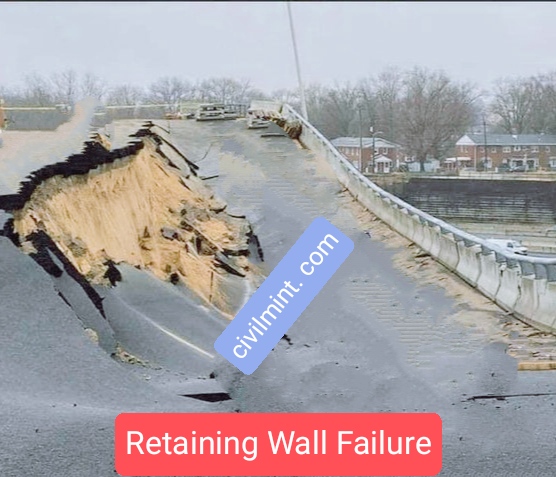There are various signs of retaining wall failure. In this blog article, I will discuss symptoms of retaining wall failure and how to address the issue of retaining wall failure.

Retaining walls are commonly used in landscaping to hold back soil and prevent erosion. While these walls are typically sturdy and reliable, they can fail if not installed correctly or if they experience excess pressure from the soil or water they are retaining. A failing retaining wall can be a serious problem, as it can lead to damage to the surrounding property or even pose a danger to people nearby. In this article, we will explore the signs and symptoms of retaining wall failure and offer suggestions for addressing the issue.
Table of Contents
Signs of Retaining Wall Failure
The key symptoms of retaining wall failure is listed below.
- Bulging or Leaning Walls: One of the most obvious signs of retaining wall failure is a bulging or leaning wall. This occurs when the wall is no longer able to support the weight of the soil behind it and starts to tilt or buckle. A bulging or leaning wall can be a serious hazard and should be addressed immediately.
- Cracks in the Wall: Another common symptom of retaining wall failure is the appearance of cracks in the wall. These cracks can be small and barely noticeable or they can be large and significant. In either case, cracks in the wall indicate that the wall is under stress and may be in danger of collapsing.
- Soil Movement: If you notice that the soil behind the retaining wall is starting to move or slide, this is a clear sign of retaining wall failure. The soil movement can be caused by excess water or pressure from the soil, and can be a serious problem if left untreated.
- Water Damage: Retaining walls are designed to hold back water, but if the wall is failing, it can actually cause water damage to the surrounding property. If you notice water pooling near the retaining wall or seeping through the wall itself, this is a sign of retaining wall failure.
- Sinking or Settlement: A retaining wall that is sinking or settling can be a serious problem, as it can cause the surrounding property to become uneven or even collapse. This can be caused by a variety of factors, including poor installation or excess pressure from the soil.
- Tilting or Shifting: If you notice that the retaining wall is tilting or shifting, this is a clear sign of failure. This can be caused by a variety of factors, including poor installation or excess pressure from the soil.
- Bulging or Bowing Walls: If the retaining wall is bulging or bowing, this is a clear sign of failure. This can be caused by a variety of factors, including poor installation or excess pressure from the soil.
- Inadequate Drainage: Retaining walls are designed to hold back water, but if the wall is failing, it may not be able to handle excess water. This can lead to inadequate drainage, which can cause further damage to the wall and surrounding property.
- Visible Foundation Issues: If you notice any issues with the foundation of the retaining wall, such as cracking or settling, this is a clear sign of failure. The foundation is the key to the stability of the wall, and any issues with the foundation should be addressed immediately.
- Separation of Blocks: If the retaining wall is made up of individual blocks, and you notice that the blocks are separating or shifting, this is a clear sign of failure. This can be caused by a variety of factors, including poor installation or excess pressure from the soil.
Addressing Retaining Wall Failure
If you notice any of the above signs of retaining wall failure, it is important to address the issue as soon as possible. The longer you wait, the more serious the problem can become, and the more expensive it can be to fix.
The first step in addressing retaining wall failure is to determine the cause of the problem. This may involve consulting with a professional engineer or contractor to assess the situation and determine the best course of action.
Depending on the severity of the problem, there are a few different options for addressing retaining wall failure:
- Repair: In some cases, minor retaining wall failure can be repaired with simple fixes like filling in cracks, reinforcing the wall, or adding drainage. It is important to hire a professional to repair the wall to ensure that the fix is done correctly.
- Rebuild: If the retaining wall is severely damaged or at risk of collapsing, rebuilding the wall may be necessary. This involves removing the existing wall and rebuilding it from scratch with new materials.
- Replace: If the retaining wall is beyond repair or rebuilding, it may need to be replaced entirely. This can be a more expensive option, but it is necessary in cases where the wall is a serious hazard.
Preventing Retaining Wall Failure
The best way to prevent retaining wall failure is to make sure that the wall is installed correctly in the first place. This involves using quality materials, ensuring proper drainage, and following best practices for installation. It is also important to regularly inspect the retaining wall for signs of damage and address any issues as soon as possible.
Wrapping Up
Retaining wall failure can be a serious problem, but it is often preventable with proper installation and maintenance. If you notice any signs of retaining wall failure, it is important to address the issue as soon as possible to prevent further damage or hazards. By taking a proactive approach to retaining wall maintenance, you can ensure that your property is safe and stable for years to come.
